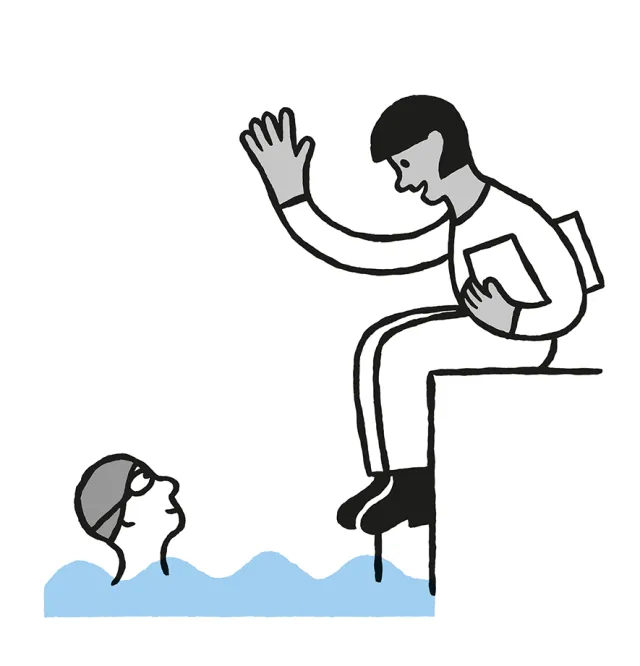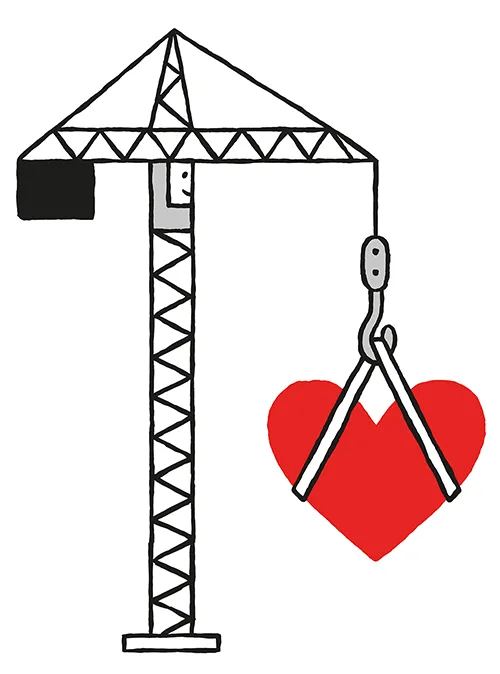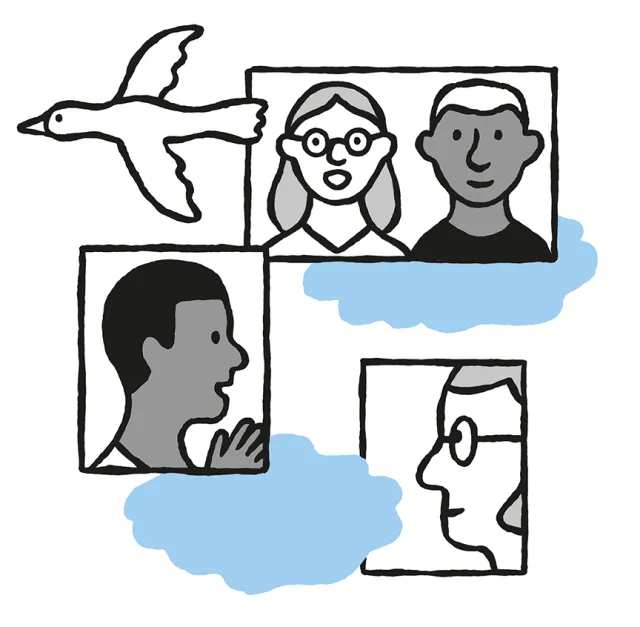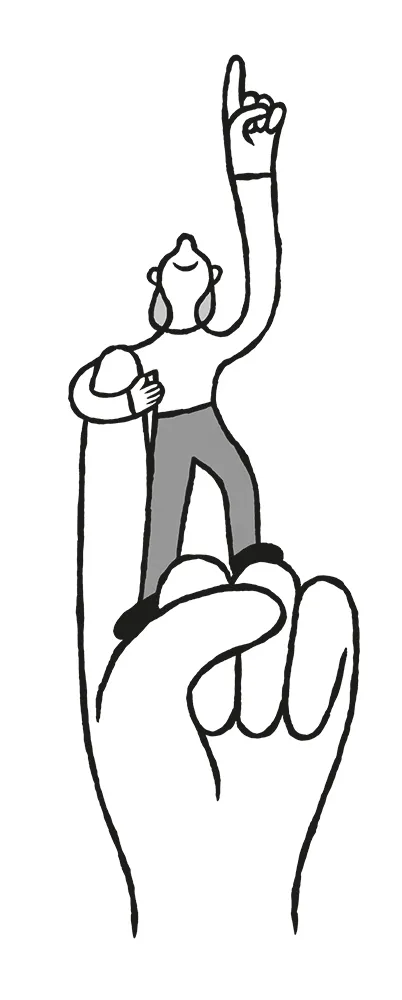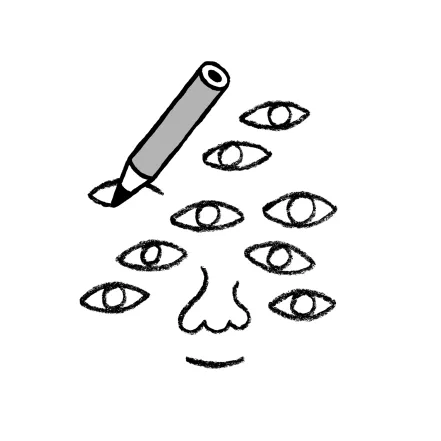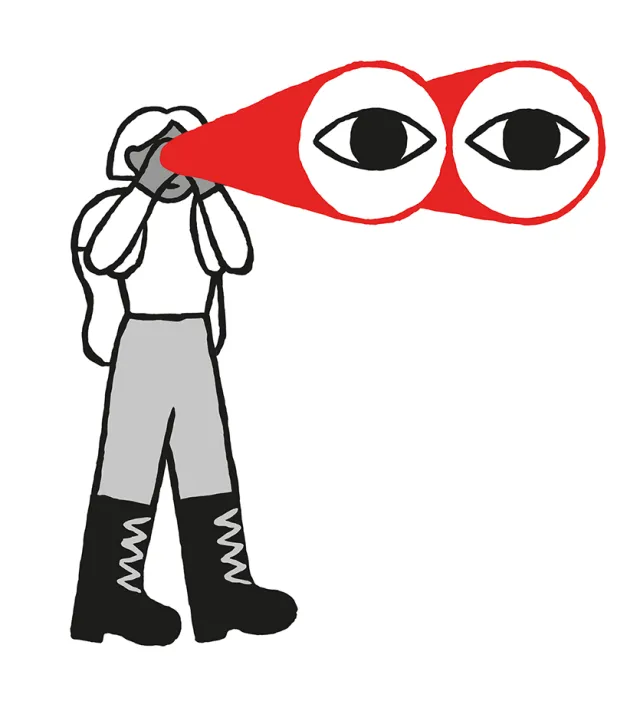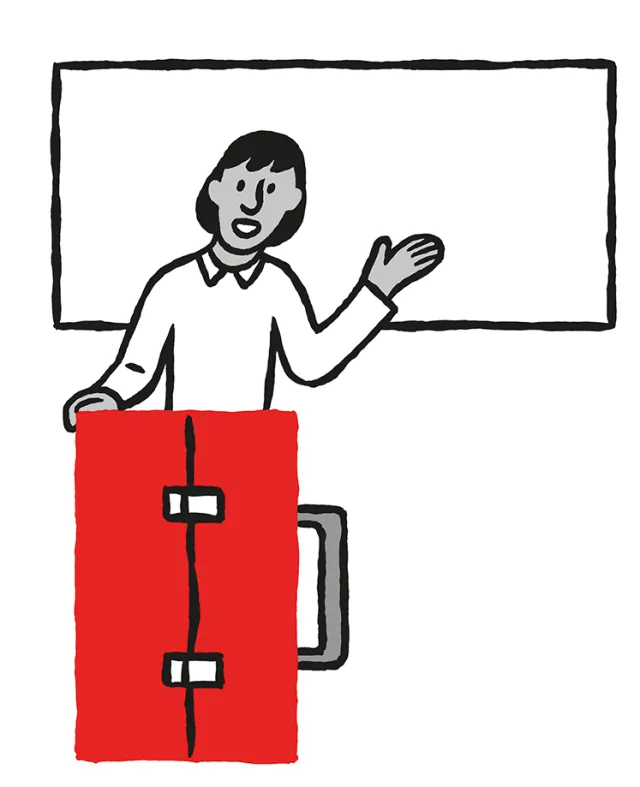Going Places
Smith Quarterly
Smith’s new playbook for career development
Illustration by Kate Dehler
Published October 15, 2024
My dad supported my desire for a liberal arts education at Smith. But he was puzzled when I declared my major as American studies. I explained that I’d explore American literature, plus courses in topics ranging from government to gender. I could tell by his expression that he wasn’t sure how all that would lead to gainful employment.
In spite of Dad’s initial worries about my prospects, I found a career in journalism that has been profoundly meaningful and satisfying. I get to talk with intriguing people and do my bit to help make sense of the world.
Still, getting a job after college is a concern that transcends generations. Families are understandably keen to see that their financial investment in college pays off in meaningful careers for their children. Students want that, too. In a 2023 survey, about 73% of incoming first-year students at Smith reported that their career aspirations were a central reason for attending college. A 2019 national survey from Eduventures Research found that 63% of undergraduates wanted their colleges or universities to help them develop skills and traits prized by employers in their chosen fields.
For Smith President Sarah Willie-LeBreton, it’s imperative that career development offices help all students develop the skills and habits of mind to be able to “choose their careers rather than to be chosen by them, to explore avenues beyond what they or their parents thought were possible, and to take the excitement they gain from the classroom, join it to the possibilities beyond campus, and ignite paths they never even considered.”
In that spirit, Smith—and the Lazarus Center for Career Development in particular—has spent the past few years reimagining career development, taking a comprehensive and critical look at the evolving needs and expectations of students, prospective employers, and the world in which future graduates will live and work. The result is a program of career education and development that aims to engage all students from the moment they set foot on campus and then guide them throughout their entire Smith experience. The idea is to first help students discover what they’re truly passionate about and then assist them in developing a vision for a career that is meaningful, consequential, and impactful.
Following are six pillars of Smith’s new career development program, plus some of the ways in which the college strives to ensure that thinking about and preparing for careers become natural parts of the Smith ecosystem.
Pillar 1: Meet students where they are
Career trajectories have changed. Today, students will most likely pursue varied jobs and careers over the course of a lifetime. Business Insider recently reported that Gen Z workers will most likely change careers at least three times in their lives; other research shows that current college students may have as many as 17 jobs over six careers.
By the time they get to college, however, many students haven’t given much thought to their career track, and even those who have will presumably change their minds as they develop their interests and expand their horizons. Knowing this, Smith’s career development program has been built to be nimble and responsive to student needs as they grow and expand. Part of that means providing students with access to different perspectives, information, and opportunities to explore at various points along their path.
Smith’s encouragement of multidisciplinary study and exploration is now amplified by six career communities. Their focus areas cover the spectrum of popular professions: arts, media, and communications; business, finance, consulting, and entrepreneurship; education, nonprofit, and social impact; government, law, policy, and international affairs; health professions; and STEM.
The career communities were developed in response to requests from students, who wanted more industry-specific advising, resources, and connections. Each community is guided by a leader in that field. The commitment to career development shows in the staffing: 13 employees when Faith McClellan, dean of career development, began her role in September 2021, versus 24 today.
Students can engage in any or all of the communities. They can also sign up for newsletters filled with helpful information about internships and fellowships. They can chat with community leaders during drop-in hours, and they can attend themed monthly lunches, alum panels, and networking events.
In addition, site visits, or “career treks,” allow students to see careers in action. In the past year, the Lazarus Center has hosted eight treks: two to New York City for arts, media, and communications; one to Washington, D.C., for government, policy, and social impact; two to Boston for technology, finance, and consulting; and three locally for museum concentrators, pre-health, and pre-law. During one Boston trek, students heard from an alum and employees at Morgan Stanley, developed insights during a case study consulting exercise at Accenture, and explored work at Cornerstone Research, a boutique economics consulting firm.
“Meeting students where they are” goes beyond responding to their requests. It’s literal. “The old message was, ‘Our advisers are here for you; come see us,’” McClellan says. “The new message is, ‘We’re all around campus,’” from orientation to house teas to the campus center. The Lazarus Center also partners with the Jill Ker Conway Innovation & Entrepreneurship Center, the Jandon Center for Community Engagement, and the Wurtele Center for Leadership to connect with students.
Conversations about careers pop up in unexpected places. For example, student athletes busy with practices and schoolwork don’t always have time to visit the Lazarus Center. So the Lazarus Center comes to the athletics center, holding drop-in hours and workshops. During the last year, 120 students completed a skills and values assessment tool called CliftonStrengths, an entry point for career exploration, at the athletics center.
“Every student has the capacity to engage in meaningful work that aligns with their interests, skills and passions.”
Pillar 2: A welcoming new building
Smithies who venture to the Lazarus Center next year will be rewarded with a new building to enjoy. Currently under construction, Kathleen McCartney Hall—named for Smith’s 11th president and sited on a hilltop overlooking Paradise Pond—will bring together the resources of both the Lazarus Center and the Wurtele Center for Leadership. It will include spaces for interviews, workshops, and recruiting events, a rooftop terrace with a living roof to aid in heating and cooling, and a well-stocked lending closet from which students can borrow professional attire for interviews.
“Why a new building?” Willie-LeBreton asked in a November keynote to the Career Leadership Collective. Her answer: “Because we want to create a central hub, a one-stop inclusive shop where our students feel welcome and supported in their professional pursuits, a building where students can imagine their futures and ask the big questions, like ‘What kind of leader do I want to be? What kind of jobs do I want to create that don’t exist? How can my work uplift others?’”
Alexandra Keller, dean of the college and vice president for campus life, says the 15,000-square-foot building—funded by the college’s capital funds as well as ongoing philanthropic support, including a lead gift from Margaret Wurtele ’67 will be the physical manifestation of Smith’s belief that career readiness and the liberal arts go hand in hand and that every student has the capacity to engage in meaningful work that aligns with their interests, skills, and passions. Even the building’s design, with its large windows and open spaces, is meant to reflect the idea that career education is a key component of the Smith experience. “From the moment prospective students come to campus for a tour, they’ll see with transparency so many ways to turn their academic and co-curricular experiences into the futures they are just beginning to imagine,” Keller says. “In every way, from the programming to the ways the space is configured, the building says, ‘Everyone belongs here.’”
Peer advisers are one of the key resources at the Lazarus Center. These trained students advise on crafting résumés and cover letters, preparing for interviews, and navigating LinkedIn and Handshake—Smith’s platform that connects students with employers and tens of thousands of job opportunities.
“I pride myself on my ability to read how the person is feeling when they walk in and match their energy,” says peer adviser Talia Blanchard ’25, who gives quick encouragement when needed or suggests major revisions to a résumé or letter if a student invites a critique.
“People seem to really love coming in,” Blanchard adds. “It’s intimidating until they step in the door. Once you get in the door and see how kind everyone in the office is, how everyone is smiling and wants to help them, how everyone’s very relaxed and laid-back and understanding—then it’s OK.”
Pillar 3: Digital connections
In advisory meetings and focus groups, Smith students asked for a technology platform that would allow them to contact and learn from alums in targeted professions on their own time. “They were less excited about a traditional mentor-match model, as in, ‘You’re assigned to this mentor for six months,’” McClellan says. “They wanted flexibility and agency in their ability to reach out.”
The Lazarus Center responded with Smith Career Connect, a custom platform to encourage student–alum conversations. Alums can post early-career job listings and advise on steps to land jobs in their fields. So far, more than 1,300 alums—including artists, authors, project managers, producers, attorneys, investment bankers, film executives, and scientists—have signed up to participate.
The technology is key to increasing the number of students reached, McClellan says. “We have over half the student body engaged with this platform.”
Even the traditional in-person career fair—where students can meet potential employers—now has a digital counterpart. One of Smith’s four career fairs is now virtual and was attended by 120 students last year. (Nearly 500 came out for the fall in-person fair.)
Pillar 4: Prioritizing equity and access
Sometimes finding a job has more to do with who you know than what’s listed on your résumé. The problem? That approach usually benefits only those job seekers with extensive personal networks. These days, more students are arriving at Smith who can’t easily seek help from parents or family friends for the kind of high-level introductions that can make or break a job search.
“We are still an elite liberal arts college. But what is the definition of ‘elite’ now?” Keller asks. “It’s about high performance and high potential, but it doesn’t any longer presume that someone’s coming in with elite networks.”
This shift has made it essential to reach populations that may have historically been underserved in career development, including first-generation, low-income, and international students. The Lazarus Center partners with student groups on campus to foster relationships with students of varied backgrounds and interests.
By reducing financial and other barriers to career development, Smith can help more students leave their undergraduate years prepared to stand out as they seek employment. Developing students’ workplace skills is part of that role. The college offers Career Launch Academy, an interterm program of career conversations and networking and interviewing skill building, with the student group First Gen Out Loud. Among the 2024 cohort, 100% of students reported more confidence in building professional relationships, according to the Lazarus Center’s 2023–24 annual report.
All students can take advantage of workshops on sought-after skills. Topics include a popular “Wall Street prep” seminar on accounting, financial statement modeling, and valuation. One recent five-day seminar gave students the chance to earn a certification in cybersecurity. Going forward, the Lazarus Center plans to add a range of skills certifications in high-demand emerging tech professions, including AI, blockchain, coding, and user experience. In subsequent years, with additional resources, the center hopes to offer a broader array of skills training programs requested by students, such as grant writing, graphic design, and project management.
Internships are an additional way to develop skills. The college’s long-standing Praxis internship program provides a one-time stipend of up to $4,500 so students can accept the internship of their choice rather than one that pays. In addition, the college has worked to ensure that off-campus internships promoted to students are robust and provide real opportunities for learning. No student wants a boring summer internship. A meaningful internship experience is especially important for students who might not have other opportunities to explore a career and who may have chosen an unpaid internship over a paid summer job.
“There’s been a huge shift” nationally, says Deborah Wijnhoven, assistant dean of employer partnerships and career communities. “Employers have really started to think of their interns as part of teams, and given them real functional responsibility within a team.” As a result, students can “imagine what they might do if they were to have this role full time, or what they don’t want to do. It gives them an insider perspective.”
Another promising venture is a job-shadowing pilot program for Smith students at partner companies. Instead of an informational interview of an hour or less, students spend two to five days with an organization. They can sit in on meetings, interview several people in different positions, and potentially pursue a small project. The idea is “to really get to know people in the industry in a unique way,” Wijnhoven says. She has organized three of these partnerships so far and hopes to form more. One corporate partner is the women-owned architecture firm TenBerke, which designed the new Kathleen McCartney Hall.
Pillar 5: Career growth and mobility
Many prestigious colleges and universities, including Smith, highlight their students’ success rate immediately following graduation. According to the Lazarus Center, 96% of Smith students are employed, in graduate school, or in full-time service programs six months after graduation. But what about afterward?
Smith now sees as part of its charge helping students cultivate a longer-range career vision, including career engagement, satisfaction, and economic mobility over time. The goal is not just a full-time job, but a fulfilling career. That intent is in keeping with Smith’s vow to ready students for purposeful engagement in the world. It’s also inherent, McClellan argues, in a rigorous liberal arts education, which “prepares graduates for nimble transitions between and across careers.”
Think of the mission as twofold: to help students build their capacity to enter the workplace in jobs both financially viable and emotionally satisfying, and to cultivate the broad skills that enable them to shift gears as their careers evolve.
This broader focus enables the Lazarus Center to be a leader among college career centers, many of which still prioritize immediate postgraduation outcomes, McClellan says. Of course, successful graduates in thriving careers may also be more likely to give back and assist current students, allowing the cycle to continue.
Data from students is an important asset to help evaluate programming. Smith has hired a data analyst and does consistent, frequent analysis to identify any gaps related to equity and make changes. The Career Launch Academy, for instance, was initiated in response to data that showed first-gen students felt less confident about reaching out to build career networks than other students. When low-income students had more difficulty accessing preparation resources for tests including the MCAT for medical school and the LSAT for law school, the Lazarus Center added funding and resources for test prep. Data gathering also uncovered the fact that Smith’s Pell Grant recipients were less likely to apply for funding from the college to attend conferences. The staff made changes in the application and in some instances increased the award amounts, leading to greater diversity in applicants.
The college gathers data using such tools as a first-destination survey of new graduates, plus surveys of first-years; sophomores when declaring their major; seniors; and graduates five, 10, and 20 years out. Students and alums respond to questions about their career confidence, next steps in their career exploration, and their career networks. Research from the Career Leadership Collective and the American Association of Colleges and Universities suggests those three early indicators can help predict long-term economic mobility.
Smith was one of four colleges and universities nationally to win the 2023 Pursuit of Excellence Award from the Career Leadership Collective, in part because of its success in analyzing student data to enhance its programming.
Pillar 6: Supporting faculty
Students naturally turn to their favorite or most trusted teachers as sources of career advice. Yet it’s impossible for faculty members to know about all the internships and opportunities in a given field. Unlike tenured professors, students may switch jobs multiple times during their careers. “Our own jobs are pretty fixed, right? It’s the goal of an academic to get tenure and stay someplace,” Keller says. “We’re always trying out new things, but we’re trying them out here. It means we are less like many of our students because we’re not changing jobs as often.”
While faculty recognize their role is distinct from career advisers, some actively tie academic learning to career experiences. After Keller and McClellan gave a presentation about career development earlier this year, dozens of faculty members approached them with requests for classroom presentations, help assembling alum panels, assistance in obtaining conference funding for students, and other kinds of support. “There are all kinds of new partnerships emerging with faculty that are really faculty-inspired and driven,” McClellan says.
Historically, she adds, there were concerns from the faculty about preserving the value of the liberal arts and “not over-professionalizing the work that we do at Smith.” Leaders at the Lazarus Center don’t disagree. After all, the goal of a liberal arts education is to learn how to think, to be able to consider ideas from many disciplines and perspectives, to make sense of the world, and to contribute to the common good. As President Willie-LeBreton once put it, the liberal arts give students the tools “to interrogate assumptions and insist on truth-telling, and to act as global citizens.” What employer wouldn’t value those qualities and traits?
“Career readiness is an amplification of the liberal arts,” Willie-LeBreton believes, “because it prepares students with a sense of agency and agility to be creative, to adapt, and to engage in meaningful work in an increasingly complex world.” •
Andrea Cooper ’83 is an independent journalist who has contributed to The New York Times, Vogue, and many other national publications.
No matter your graduation year, Smith is here for you
The Lazarus Center for Career Development offers virtual services for alums up to five years after graduation. But what if you graduated a decade ago or more and want career guidance, enhanced skills, networking, or an entirely new direction?
In the Office of Alumnae Relations and Development, Christie Capone Kennedy ’10 leads a robust professional program for alums, including free webinars with career experts and a job board with opportunities. To get a sense of what’s available, look up the Career Hub section of The Network, Smith’s alum platform. Identify and contact fellow alums for networking in and outside of your industry. For one-on-one advice, explore a listing of alum career coaches. (A sample description from Jamie Lee ’04: “Helping smart women who hate office politics get promoted and better paid without throwing anyone under the bus.”) Take advantage of free LinkedIn Learning courses, from project management to audio recording, plus videos from Smith and alums on career topics.

